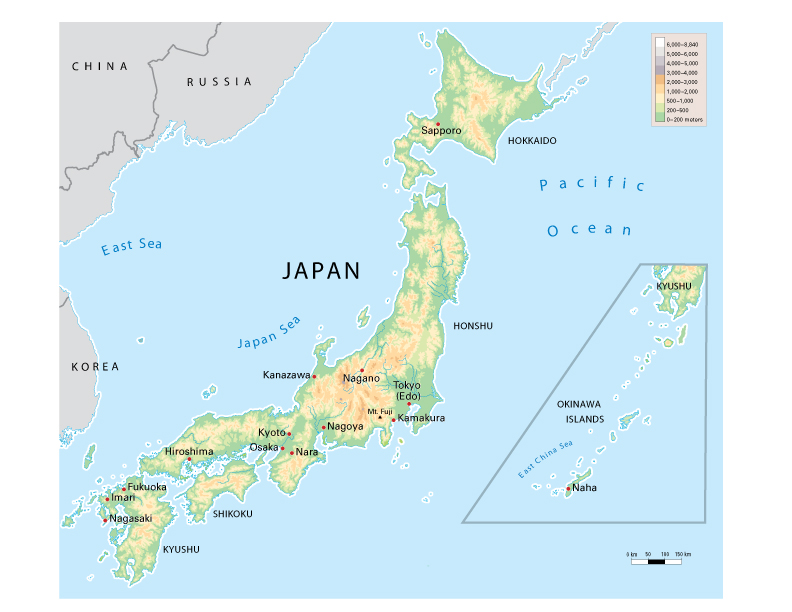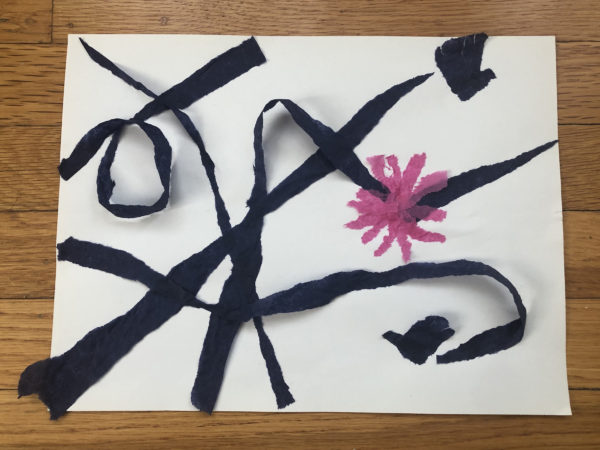Activity
Map Activity: Japan’s Warrior Government
Objective: Students will complete a map of Japan, identify how its proximity to China and Korea influenced samurai culture, and discuss how its geography informed governing policies.

Map of Japan
Standards (California Department of Education):
History-Social Sciences: Chronological and Spatial Thinking; Historical Interpretation; Research and Evidence: 7.7.5, 7.5.1, 7.5.3, 7.5.4, 7.5.6; Visual and Performing Arts: Connections, Relationships, Applications: 5.5.2; Historical and Cultural Context: 3.3.3
Materials:
Worksheets: Student Worksheet; Teacher’s Answer Key; Map of Japan; Artworks (see “Related Resources” below): Seated Buddha Amitabha; Taming the Ox; Matchlock pistol; Palanquin; Traveling chest
Procedure:
1. Show the Map of Japan.
- Ask students to discuss the advantages and disadvantages of living on an island (sea trade, could control degree of isolation).
- Explain that the proximity of Korea and China to Japan influenced Japanese art and culture.
2. Show Seated Buddha Amitabha.
- Discuss the influence of Korea on Japan such as Buddhism. (Buddhism came to Japan through Korea during the middle of the sixth century. It grew in popularity during the Kamakura period (1185–1333). This religion may have appealed to warriors because of the belief that everyone could attain immediate salvation. This belief comforted them in battle.)
3. Show Taming the Ox
- What is going on in this picture? How might this illustrate a Buddhist lesson? (Metaphor for controlling one’s mind to achieve enlightenment.)
- Explain: Ink and brush paintings from China, like the image Taming the Ox, were collected by the wealthy elite in Japan, and were a respected art form studied and practiced by daimyo and their samurai, as well as by monks. Other objects and ideas that came from China include tea, horses, and the idea of creating a clan crest to denote identity. Japan also studied Chinese ideas including philosophy and religion. Zen may have appealed to the warriors because it taught that one could achieve instantaneous enlightenment. One Zen tradition used a form of meditation that focuses on studying paradoxical questions or comments known as koan.
4. Show the Map of Japan.
- Ask students to describe the topography.
- Explain that because of Japan’s mountainous terrain, the emperor, and later, the shoguns relied on a lord–vassal system to maintain centralized control. Although the imperial capital remained in Kyoto, the Minamoto clan (Genji) moved their political capital to Kamakura (1192–1333). Hence, this period is usually called the Kamakura period. The Ashikaga clan moved the capital to the Muromachi area of Kyoto. This period is often called the Muromachi period (1336–1573). The Tokugawa clan moved the capital to Edo (present day Tokyo). This is often called the Edo period (1615–1867).
5. Discuss the influence of trade and guns on Japan.
- Show Artwork: Matchlock pistol (Up until the 1500s, Japan was involved with trade and exchange with Europe and the rest of Asia. During the 1500s, the Portuguese introduced the gun.)
- Ask: How do you think that the introduction of firearms influenced the shogun and daimyo’sability to maintain control? (Threatened the stability of the power hierarchy, leading Japan to close off its borders except for the port at Nagasaki.)
- Ask: If you were the shogun, would you enforce gun control? Why or why not?
- Explain: During the Edo period, the Tokugawa shogun also wanted to prevent rival families from usurping his power. The Tokugawa shogun divided up the land among daimyo who had supported him, and insisted that every other year, the daimyo, his samurai, and their families live in the capital at Edo. The damiyo were required to travel from their region to Edo in a ceremonial procession. What do you think it was like to take this trip? There were no trains, cars, or busses. Imagine what it was like to travel such a long distance on foot.
6. Explore the ways a shogun maintained a centralized government.
- Show Artwork: Palanquin and Traveling chest
- Some women would get to ride in this palanquin instead of walking. Why do you think the Shogun insisted that daimyo, their families, and their retinue travel to the capital in such elaborate processions? (One theory is that this expense was another way that the shogun prevented the daimyo from acquiring too much wealth, and subsequently, power.)
- Explain: Warrior clans also signified their position when traveling by displaying their clan’s crest, a mon. The chest both holds the family crest of the Tokugawa family. The mon is a symbol made up of stylized geometric forms based on nature. Samurai were identified by the mon of the daimyo they served. The concept of a mon was also imported from China centuries ago. The mon would be placed on weapons, armor, banners, and clothing. Today, Japanese families register their mon at city hall. With the mon, many families can trace their lineage back into hundreds of years of history.
7. Complete the student worksheet Map Activity: Japan’s Warrior Government.
Further Research:
Why was the material and intellectual culture in Japan so heavily influenced by China and Korea prior to the establishment of the shogunate? What else was appropriated from China and Korea into Japanese culture? What aspects of Japanese culture influenced Korea and China?








